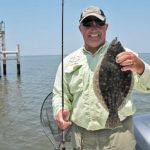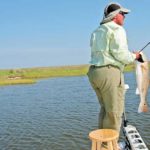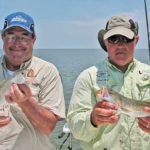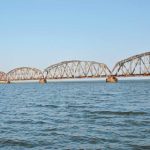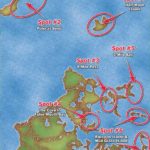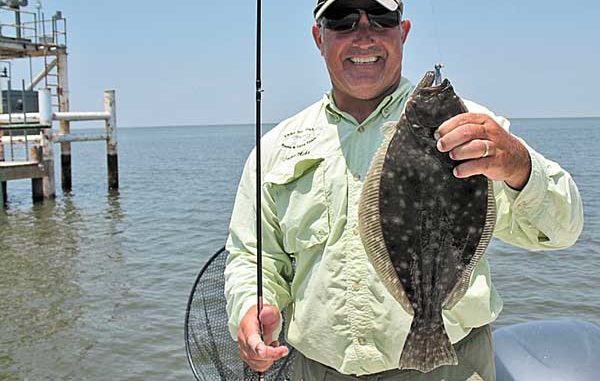
The hottest summer days do nothing but turn on the fish at these Lake Borgne-area destinations.
Here in the Gulf South, August is traditionally the hottest month of the year. We’re all hoping this year will be the exception because our summer heat has been blistering and record-setting so far. The stifling heat takes a toll on our physical endurance and forces anglers to make adjustments to their normal game plans. Many are opting to fish early and quit early to beat the heat, while others do the opposite — fishing late until darkness forces them in.
Many others simply choose to sit home, soak up the A/C and wait for the fall fishing season.
Drop outs.
Unless you have a medical condition that prevents you from getting outside, consider a couple of options that will enable you to cope with the heat, catch some fish and actually have an enjoyable trip, even in August.
One of the simplest ways to beat the heat is to install a Bimini or T-top on your boat. I’ve fished under both through the years, and while they are awkward and can be difficult to fish around, they can keep your brain from frying during summers like this. In fact, it still amazes me how comfortable you can be when you have shade to fish under, even on these extremely hot days. If there is any breeze at all, it is very bearable. The problem comes in on the days when there is no wind at all, only heat and humidity.
The oppressive heat can also take a toll on our tow vehicles and trailers, and all anglers should give some extra care to ensure their trucks and trailers are up to the task.
And the heat affects the fish we seek. If it’s trout you’re after, you’ll have to fish early around beaches and shorelines because those fish are heading into deeper water as the sun comes up. That means structure and platforms in water 5 to 6 feet and deeper are probably going to produce best. But August can sometimes be a tough month for trout anglers.
Capt. Mike Gallo (985-781-7811) fishes the Rigolets area, and has his own method of dealing with the summer doldrums that can affect trout.
“Typically, August makes you work for fish,” Gallo said. “You don’t usually limit out in one spot like you do earlier in the summer. You have to move and hunt a lot more, and trout can become scarce this month, so often I’ll simply target redfish in the Biloxi Marsh in August.”
I hopped aboard his 23-foot bay boat recently on one of our sweltering summer days to check out his routine. He said he’d show me his tactics and hotspots that can make for a successful August trip, as long as I promised not to tell anybody. So I crossed my fingers and promised.
The plan was to leave the dock before daybreak to get an early start, so Perry Matulich and I climbed aboard for the pre-dawn run.
1. The CSX Train Bridge. Our first stop was directly under the CSX Train Bridge over the Rigolets. Gallo slung a rope over some bracing underneath the bridge, tied us off at the bow, and we loaded our hooks with live shrimp. I knew we’d be fishing the bottom, so I came prepared with a sliding-sinker rig ready to fish. Gallo took one look at my sinker, and said I needed to add some weight to get my bait to the bottom.
“When there is a good tide moving, whether rising or falling, you have to have enough weight to get your bait all the way to the bottom,” he said. “You want your bait to go straight down, and you want to feel it on the bottom.”
I quickly added an additional weight to my line, and tossed it upcurrent of the boat.
“I actually prefer to fish this bridge on a falling tide,” Gallo said, “and I find it produces best on days with slight tidal movement, say, half a foot or so.”
But on this particular morning, Gallo had two ¾-ounce weights tied to the bottom of a drop-shot rig to be sure his bait reached bottom.
“The key is just get your bait to the bottom. Add weight as needed to do that,” he said. “Sometimes we wail on the fish right here. It’s deep, there’s good current and bait is always being swept through this channel in one direction or the other, depending on the tide. The fish know it, and they show up to feed, and we know it, so we show up to catch them.”
We did catch some fish there. Several specks, a few white trout, a flounder and a channel mullet all joined our party under the train bridge. Gallo says on some days, he limits out right there — one-stop shopping. He says reds and sheepshead and drum are also common catches under the bridge.
But the sun was now up, and we were all itching to make the run across Lake Borgne into the upper Biloxi Marsh, where Gallo had been on a good redfish bite.
2. Polecat Bend. “Before we run across the lake, we’ll make a pass through Polecat Bend,” Gallo said.
Polecat Bend is a long sweeping cove on the bottom of the north shore, between the Rigolets and the Pearl River. It is pretty shallow, and has a good sand bottom. Reds, specks and flounder seem to favor the area.
Several boats were already there when we arrived, some anchored, others trolling and casting, and we gave them plenty of space before inching with the trolling motor toward some structure. Gallo said the structure was the remnants of an old pier that extends well out from the shoreline, and is a favorite haunt of reds and specks.
But on that morning, despite our best offerings of live shrimp and plastic, the fish were a no show. Gallo enacted his “10-minute rule,” and we pulled out to search for redder pastures.
The run across Lake Borgne was bumpier than expected, and Gallo ran behind Half Moon Island to hide from some of the waves.
“We’ll fish this area on the way back,” he said as we re-emerged into Lake Borgne’s swells and made our way toward Nine Mile Pass.
3. Nine Mile Pass. “Nine Mile Pass has a deep center, dropping down to 30 feet in some areas, and it has a good slope and flats on both sides,” Gallo said. “You often see shrimp boats dragging their nets in here because it is a pass with good water flow and, obviously, a lot of bait. And where there’s bait, there’s fish that eat them.”
Gallo says this is a good August spot to fish the shallow ledges early, and then fish deeper along the ledges as the sun heats up the water.
“If you don’t know where the ledges are, look for the crab traps,” he advised. “Apparently, crabs and fish like to move through these areas along the ledges and drop offs, and crabbers will place their traps right along their path. Live shrimp under a popping cork or on the bottom is the best bet.”
4. The cove in False Mouth Bay. Gallo is persuaded that shorelines with roseau cane or brush almost always have a hard bottom, and those areas are more productive to fish.
“Fish like to hunt in areas with harder bottoms because the shrimp, small crabs and baitfish they eat can’t burrow into the bottom to hide,” he said.
The theory makes sense, and we dropped the trolling motor over the bow to put it to the test.
Gallo says redfish, drum, flounder and specks will all haunt these hard-bottomed coves, and trolling slowly while casting live shrimp under a cork should entice something to bite.
The water in the cove was clear, and we could actually see redfish hanging in the grass along the shoreline. We’d toss our shrimp ahead of them, and as often as not, they’d nail it, and the fight would be on.
Once we trolled past the area where most of the action was, we returned and re-trolled the area again. I did notice that the area of the bank that had roseau cane or brush was definitely more productive, so I’d say Gallo’s theory has merit. If you have to choose between fishing an area of the shoreline that has plain marsh grass or an area with brush or roseau, choose the latter.
5. Three Mile Bay. Gallo says the whole cove, from Roy’s Point to Shell Point, is a great place to troll for reds and occasional drum and flounder. Live shrimp under a cork is the best bet, but reds will also hit spinnerbaits, gold spoons, plastics and topwater baits, he said.
6. Raccoon Island and Mud Grass Island. “There are some great points and coves on both of those islands,” Gallo said. “Sometimes I’ll just run with the outboard motor looking for a good current line or water flow around the points, or signs of baitfish in the coves, or slicks on the surface. Move in quietly with the trolling motor, and fish wherever you find signs that could indicate the presence of reds or specks.”
7. Half Moon Island. By the time we got back to Half Moon, we had an ice chest full of reds. We’d caught and released numerous white trout, channel mullet, big croakers, undersized specks and a couple drum and sheepshead. We had a few flounder in the box with the reds, and hoped to pick up a few decent specks around the big island. Gallo said it often holds specks off the points, and we trolled about 50 feet off the shore casting live shrimp under popping corks. We had hits almost immediately. We landed numerous speckled trout, about half of them undersized, but some good keepers in the mix, and we landed a bunch of 11- to 12-inch white trout, all of which we released.
Gallo was manning the trolling motor trying to position us to cast into the area where we caught the largest trout when he yelled, “Tripletail!” He was pointing just ahead of the bow at a dark mass on the surface, a hovering tripletail in open water.
I tossed a live shrimp under a cork at the target, missed by a country mile and reeled in to try again before the big fish submerged. The fish was diving when I made my second attempt, and I think I must have hit it right on the head because I frightened it away. So much for my casting accuracy.
Gallo says tripletail are not unusual in this section of Lake Borgne.
“They like to hang out anywhere from Half Moon Island to Unknown Pass and Chef Pass, and usually they hover around the crab traps,” he said. “If you see any kind of debris or flotsam or lily pads or anything at all floating in the water, even a Coke can, it’s worth checking out because I’ve even caught tripletail under a Coke can.”
Gallo caught 150 of the tasty fish the year after Katrina, and he’s caught quite a few every year since.
“Not enough to make a trip specifically to target them, but they are a great bonus fish to target on the way back across Lake Borgne,” he said.
We were calling it a day, heading back toward the Rigolets, when Gallo yelled, “tripletail,” once again. Another fish was hovering on the surface in open water.
“Unusual,” Gallo said, as he tossed a live shrimp a foot or so in front of him. This time, the fish inhaled the bait, and the fight was on. Minutes later, I netted the 5- to 6-pound fish, and we added it to our box.
“Look on a map of the upper Biloxi Marsh area where we were fishing, and you’ll see dozens of islands with great coves and points, all of which potentially hold fish, and this is a great month to explore them,” Gallo said on the ride in. “I just took you on a tour of some of my favorite August hotspots, but let’s keep it between you and me, OK?” he said.
“No problem,” I replied with a wink, “your secrets are safe with me.”
Capt. Mike Gallo can be reached at (985) 781-7811.
